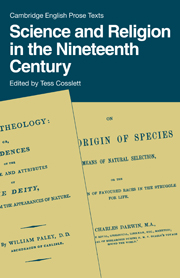Book contents
- Frontmatter
- Contents
- Editorial note
- Introductory essay
- 1 WILLIAM PALEY, Natural Theology (1802), Chapters 1–3
- 2 ROBERT CHAMBERS, Vestiges of the Natural History of Creation (1844), Chapter 14, ‘Hypothesis of the Development of the Vegetable and Animal Kingdoms’
- 3 HUGH MILLER, The Testimony of the Rocks (1857), Lecture Fifth, ‘Geology in its Bearings on the Two Theologies’, Part I
- 4 CHARLES DARWIN, On the Origin of Species (1859), Chapter 14, ‘Recapitulation and Conclusion’
- 5 CHARLES GOODWIN, ‘On the Mosaic Cosmogony’, Essays and Reviews (1860)
- 6 LEONARD HUXLEY, Life and Letters of Thomas Henry Huxley (1903), vol. 1, Chapter 14, ‘1859-1860’
- 7 CHARLES DARWIN, The Descent of Man (1871), Chapter 21, ‘General Summary and Conclusion’
- 8 JOHN TYNDALL, ‘The Belfast Address’, Nature, 20 August 1874
- 9 FREDERICK TEMPLE, The Relations between Religion and Science (1884), Lecture VI, ‘Apparent Collision between Religion and the Doctrine of Evolution’; and Lecture VIII, ‘The Conclusion of the Argument’
- Notes
- Select booklist
7 - CHARLES DARWIN, The Descent of Man (1871), Chapter 21, ‘General Summary and Conclusion’
Published online by Cambridge University Press: 18 January 2010
- Frontmatter
- Contents
- Editorial note
- Introductory essay
- 1 WILLIAM PALEY, Natural Theology (1802), Chapters 1–3
- 2 ROBERT CHAMBERS, Vestiges of the Natural History of Creation (1844), Chapter 14, ‘Hypothesis of the Development of the Vegetable and Animal Kingdoms’
- 3 HUGH MILLER, The Testimony of the Rocks (1857), Lecture Fifth, ‘Geology in its Bearings on the Two Theologies’, Part I
- 4 CHARLES DARWIN, On the Origin of Species (1859), Chapter 14, ‘Recapitulation and Conclusion’
- 5 CHARLES GOODWIN, ‘On the Mosaic Cosmogony’, Essays and Reviews (1860)
- 6 LEONARD HUXLEY, Life and Letters of Thomas Henry Huxley (1903), vol. 1, Chapter 14, ‘1859-1860’
- 7 CHARLES DARWIN, The Descent of Man (1871), Chapter 21, ‘General Summary and Conclusion’
- 8 JOHN TYNDALL, ‘The Belfast Address’, Nature, 20 August 1874
- 9 FREDERICK TEMPLE, The Relations between Religion and Science (1884), Lecture VI, ‘Apparent Collision between Religion and the Doctrine of Evolution’; and Lecture VIII, ‘The Conclusion of the Argument’
- Notes
- Select booklist
Summary
As we have seen, the Origin hinted at man's inclusion in Darwin's evolutionary theory, and both critics and supporters were not slow to seize on the hint. But Darwin waited until 1871 to make public his views on the matter. He had in a sense been anticipated by the publications of his friends Huxley and Lyell. Huxley's Man's Place in Nature and Lyell's Antiquity of Man both came out in 1863. Huxley, continuing and developing his argument with Wilberforce and Owen, had shown the near physical resemblance between man and the apes: ‘the proposition holds good, that the differences between Man and the Gorilla are of smaller value than those between the Gorilla and some other Apes’ (Collected Essays (1893-4), vol. 7, p. III). Lyell had established that fossil remains of men were deposited at the same time as those of some extinct animals, thus disposing of the theory that man had only been created after the last ‘catastrophe’. He had also given rather half-hearted and tentative support to Darwin's hypothesis. It was now up to Darwin to apply his theory of natural selection to the evolution of man. But this is just where the difficulty lay: to start with, Darwin himself had come increasingly to doubt the unaided power of natural selection, and a large part of the Descent is devoted to discussing a quite different mechanism, sexual selection.
- Type
- Chapter
- Information
- Science and Religion in the 19th Century , pp. 156 - 171Publisher: Cambridge University PressPrint publication year: 1984



